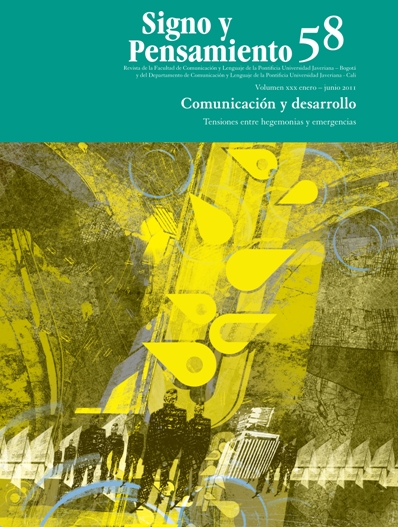Abstract
The work deals with analyzing how the media gives visibility to a social sector that meets your trash tasting existence through the use of chariots and horses in the city of Rio Cuarto. The cart drivers, rag pickers and recyclers, among other names, focus here Rurbano actors. The text shows that particularly the local tv and the press make visible some features over others and paying certain stigmatization. In this regard, we discuss the budgets that support that view and offer different interpretations that complicate and proposes a different perspective to understand and promote this Rurbano table against other socially plausible readings.
Berger, J. (2001), Puerca Tierra, Madrid, Suma de Letras.
Blanco de Castilla, E. (2008), “Periodismo ambiental. El caso español”, en Marques de Melo, J., Mídia, ecología e sociedades, São Paulo, Intercom.
Bueno, W. (2008), “As síndromes do jarnalismo ambiental brasileiro”, en Marques de Melo, J., Mídia, ecología e sociedades, São Paulo, Intercom.
Carlosena, M. A. (2009), Política pública y rurbanidad, Río Cuarto, Departamento de Ciencias de la Comunicación, Universidad de Río Cuarto.
Castoriadis, C. (1983), La institución imaginaria de la sociedad i, Barcelona, Tusquets.
Cimadevilla, G. (1998), “La comunicación entre dudas, paradojas y algunas razones siempre provisorias”, Temas y Problemas de Comunicación, año 6, vol. 8, Universidad de Río Cuarto.
— (2003), “Prensa mercado y artificialización ambiental. De cómo lo rural se vuelve agropecuario”, en Cronía [Revista de Investigación de la fch-unrc], vol. 2, núm. 4-4(2), Universidad de Río Cuarto.
— (2004), Dominios. Crítica a la razón intervencionista, la comunicación y el desarrollo sustentable, Buenos Aires, Prometeo.
— (2005), “Información ambiental, espectacularización y desconexión”, en Mato, D., Políticas de economía, ambiente y sociedad en tiempos de globalización, Caracas, ucv-cipost.
Demarchi, P. (2007), “La actividad rurbana en la prensa local”, en Cimadevilla, G. y Carniglia, E., Relatos sobre la rurbanidad, Río Cuarto, Ediciones Universidad de Río Cuarto.
De Imaz, J. L. (1974), Los hundidos, Buenos Aires, La Bastilla.
Dickens, C. (2002, 17 de junio) [1836], “Textos varios”, The Times, en diario El Mundo [en línea], disponible en http://www.elmundo.es.
Fanon, F. (2007) [1961], Los condenados de la tierra, Buenos Aires, fce.
Galimberti, S. (2008), Más que carros y caballos. Rurbanidad, objetos y significados, Río Cuarto, tfl Departamento de Ciencias de la Comunicación, Universidad de Río Cuarto.
Galimberti, S. y Kenbel, C. (2009), “Rurbanidad, mestizajes y destiempos”, en Cimadevilla, G. y Carniglia, E., Relatos sobre la rurbanidad, Río Cuarto, Ediciones Universidad de Río Cuarto.
Galpin, C. (1918), Rural Life, Nueva York, The Century Co.
Garófalo, A. (2009), “El Programa de Recuperadores Urbanos de Residuos. Un informe desde la intervención municipal”, en Cimadevilla, G. y Carniglia, E., Relatos sobre la rurbanidad. Río Cuarto, Ediciones Universidad de Río Cuarto.
Giuliani, J. C. y Valduvino, C. (2005, 28 de abril), “Puntal, el diario nuestro” [en línea], Prensared, disponible en http://www.cispren.com.ar/indexmain. php?lnk=0&mnu=0&idnota=2112, recuperado: 10 de octubre de 2010.
Gurvitch, G. (1969), Dialéctica y sociología, Madrid, Alianza Editorial. Habermas, J. et al. (1980), Os pensadores, São Paulo, Abril Cultural.
Kopytoff, I. (1986), “La biografía cultural de las cosas: la mercantilización como proceso”, en Appadurai, A., La vida social de las cosas, México, Grijalbo.
Margulis, M. (1971), Migración y marginalidad en la sociedad argentina, Buenos Aires, Paidós.
— (2009), Sociología de la cultura, Buenos Aires, Biblos. Martín-Barbero, J. (1978), Comunicación masiva: discurso y poder, Quito, Época.
— (1998), “Medios, olvidos y desmemorias”, [en línea], disponible en http://www.revistanumero.com/24medios.htm, recuperado: 10 de octubre de 2010.
Monteiro, R. (2009), “Los que hacen las noticias en la TV local. La construcción de las ‘actividades de refugio’”, en Cimadevilla, G. y Carniglia, E., Relatos sobre la rurbanidad, Río Cuarto, Ediciones Universidad de Río Cuarto.
This journal is registered under a Creative Commons Attribution 4.0 International Public License. Thus, this work may be reproduced, distributed, and publicly shared in digital format, as long as the names of the authors and Pontificia Universidad Javeriana are acknowledged. Others are allowed to quote, adapt, transform, auto-archive, republish, and create based on this material, for any purpose (even commercial ones), provided the authorship is duly acknowledged, a link to the original work is provided, and it is specified if changes have been made. Pontificia Universidad Javeriana does not hold the rights of published works and the authors are solely responsible for the contents of their works; they keep the moral, intellectual, privacy, and publicity rights.
Approving the intervention of the work (review, copy-editing, translation, layout) and the following outreach, are granted through an use license and not through an assignment of rights. This means the journal and Pontificia Universidad Javeriana cannot be held responsible for any ethical malpractice by the authors. As a consequence of the protection granted by the use license, the journal is not required to publish recantations or modify information already published, unless the errata stems from the editorial management process. Publishing contents in this journal does not generate royalties for contributors.


